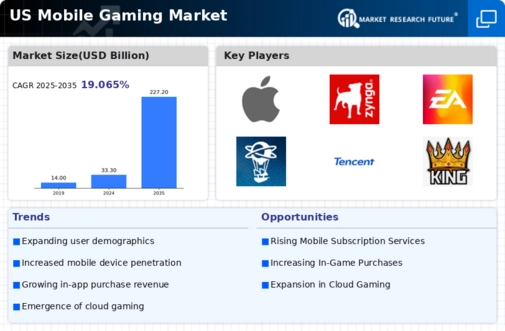Diverse Monetization Strategies
The mobile gaming market characterizes a variety of monetization strategies that cater to different player preferences. In 2025, free-to-play models dominate the market, accounting for over 70% of mobile game revenues. These models often incorporate in-app purchases, allowing players to enhance their gaming experience without upfront costs. Additionally, subscription services are gaining traction, providing players with access to a library of games for a monthly fee. This diversification in monetization strategies enables developers to reach a broader audience and maximize revenue potential. As players become more accustomed to these models, the mobile gaming market is likely to evolve further, with innovative approaches to monetization that could reshape the landscape of mobile gaming.
Increased Smartphone Penetration
The mobile gaming market experiences substantial growth due to the rising penetration of smartphones in the US. As of 2025, approximately 85% of the US population owns a smartphone, which serves as a primary device for gaming. This widespread accessibility enables a diverse demographic to engage with mobile games, from casual players to dedicated gamers. The mobile gaming market benefits from this trend, as developers create games tailored to various skill levels and interests. Furthermore, the availability of affordable smartphones with advanced processing capabilities enhances the gaming experience, allowing for more complex and visually appealing games. This trend indicates that as smartphone ownership continues to rise, the mobile gaming market is likely to expand, attracting new players and increasing revenue opportunities for developers and publishers alike.
Advancements in Mobile Technology
Technological advancements play a pivotal role in shaping the mobile gaming market. Innovations in mobile hardware, such as improved processors and graphics capabilities, enable developers to create more sophisticated games. As of 2025, the average smartphone features processors that can handle high-definition graphics and complex gameplay mechanics, which enhances user experience. Additionally, the rollout of 5G technology facilitates faster download speeds and reduced latency, allowing for seamless online gaming experiences. This technological evolution not only attracts more players but also encourages developers to push the boundaries of game design. Consequently, the mobile gaming market is likely to see an influx of high-quality games that leverage these advancements, potentially increasing user engagement and monetization opportunities.
Enhanced Social Features in Games
The integration of enhanced social features within mobile games is transforming the mobile gaming market. As of 2025, many games incorporate social elements such as multiplayer modes, leaderboards, and in-game chat functionalities, fostering a sense of community among players. This trend aligns with the growing demand for social connectivity in gaming experiences, as players seek to engage with friends and other gamers. The ability to share achievements and compete with others enhances player retention and encourages regular gameplay. Consequently, the mobile gaming market is likely to see an increase in user engagement and community-driven content, which could further solidify the position of mobile games as a primary entertainment medium.
Growing Esports and Competitive Gaming
The rise of esports and competitive gaming significantly influences the mobile gaming market. In 2025, the popularity of mobile esports tournaments attracts millions of viewers and participants, creating a vibrant ecosystem for competitive play. Major titles such as PUBG Mobile and Call of Duty Mobile have established dedicated esports leagues, offering substantial prize pools and sponsorship opportunities. This trend not only elevates the status of mobile gaming but also encourages developers to invest in competitive features and community engagement. As the audience for mobile esports continues to grow, the mobile gaming market is likely to benefit from increased visibility and investment, fostering a culture of competition that could drive further innovation and player retention.

























Leave a Comment